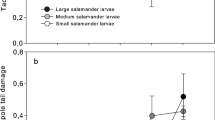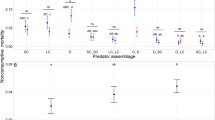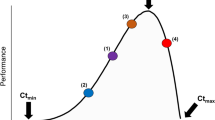Abstract
Predicting the impacts of climate change on communities requires understanding how temperature affects predator–prey interactions under different biotic conditions. In cases of size-specific predation, environmental influences on the growth rate of one or both species can determine predation rates. For example, warming increases top–down control of food webs, although this depends on resource availability for prey, as increased resources may allow prey to reach a size refuge. Moreover, because the magnitude of inducible defenses depends on predation rates and resource availability for prey, temperature and resource levels also affect phenotypic plasticity. To examine these issues, we manipulated the presence/absence of predatory Hynobius retardatus salamander larvae and herbivorous Rana pirica tadpoles at two temperatures and three basal resource levels. and measured their morphology, behavior, growth and survival. Prior work has shown that both species express antagonistic plasticity against one another in which salamanders enlarge their gape width and tadpoles increase their body width to reach a size-refuge. We found that increased temperatures increased predation rates, although this was counteracted by high basal resource availability, which further decreased salamander growth. Surprisingly, salamanders caused tadpoles to grow larger and express more extreme defensive phenotypes as resource levels decreased under warming, most likely due to their increased risk of predation. Thus, temperature and resources influenced defensive phenotype expression and its impacts on predator and prey growth by affecting their interaction strength. Our results indicate that basal resource levels can modify the impacts of increased temperatures on predator–prey interactions and its consequences for food webs.



Similar content being viewed by others
References
Anderson MT, Kiesecker JM, Chivers DP, Blaustein AR (2001) The direct and indirect effects of temperature on a predator–prey relationship. Can J Zool 79:1834–1841
Baldridge AK, Smith LD (2008) Temperature constraints on phenotypic plasticity explain biogeographic patterns in predator trophic morphology. Mar Ecol Prog Ser 365:25–34
Beckerman AP, Rodgers GM, Dennis SR (2010) The reaction norm of size and age at maturity under multiple predator risk. J Anim Ecol 79:1069–1076
Benard MF (2004) Predator-induced phenotypic plasticity in organisms with complex life cycles. Annu Rev Ecol Evol Syst 35:651–673
Bennett AM, Pereira D, Murray DL (2013) Investment into defensive traits by anuran prey (Lithobates pipiens) is mediated by the starvation-predation risk trade-off. PLoS ONE 8:e82344
Bourdeau PE, Johansson F (2012) Predator-induced morphological defences as by-products of prey behavior: a review and prospectus. Oikos 121:1175–1190
Brown JH, Gillooly JF, Allen AP, Savage VM, West GB (2004) Toward a metabolic theory of ecology. Ecology 85:1771–1789
Cahill AE, Aiello-Lammens ME, Fisher-Reid MC, Hua X, Karanewsky CJ, Ryu HY, Sbeglia GC, Spagnolo F, Waldron JB, Warsi O, Wiens JJ (2013) How does climate change cause extinction? Proc R Soc Lond B 280:20121890
Chaves-Campos J, Coghill LM, García de Leon FJ, Johnson SG (2012) The effect of aquatic plant abundance on shell crushing resistance in a freshwater snail. PLoS ONE 7:e44374
Cohen JE, Pimm SL, Yodzis P, Saldaña J (1993) Body sizes of animal predators and animal prey in food webs. J Anim Ecol 62:67–78
Coley PD, Bryant JP, Chapin FS (1985) Resource availability and plant antiherbivore defense. Science 230:895–899
Edgell TC, Rochette R (2008) Differential snail predation by an exotic crab and the geography of shell-claw covariance in the northwest Atlantic. Evolution 62:1216–1228
Englund G, Ӧhlund G, Hein CL, Diehl S (2011) Temperature dependence of the functional response. Ecol Lett 14:914–921
Hoekman D (2010) Turning up the heat: temperature influences the relative importance of top–down and bottom–up effects. Ecology 91:2819–2825
Johansson F, Andersson J (2009) Scared fish get lazy, and lazy fish get fat. J Anim Ecol 78:772–777
Kishida O, Nishimura K (2004) Bulgy tadpoles: inducible defense morph. Oecologia 140:414–421
Kishida O, Nishimura K (2006) Flexible architecture of inducible morphological plasticity. J Anim Ecol 75:705–712
Kishida O, Mizuta Y, Nishimura K (2006) Reciprocal phenotypic plasticity in a predator–prey interaction between larval amphibians. Ecology 87:1599–1604
Kishida O, Trussell GC, Nishimura K (2009) top–down effects on antagonistic inducible defense and offense. Ecology 90:1217–1226
Kishida O, Trussell GC, Mougi A, Nishimura K (2010) Evolutionary ecology of inducible morphological plasticity in predator–prey interaction: toward the practical links with population ecology. Popul Ecol 52:37–46
Kishida O, Costa ZJ, Tezuka A, Michimae H (2014) Inducible offences affect predator–prey interactions and life-history plasticity in both predators and prey. J Anim Ecol 83:899–906
Kopp M, Tollrian R (2003a) Trophic size polyphenism in Lembadion bullinum: costs and benefits of an inducible offense. Ecology 84:641–651
Kopp M, Tollrian R (2003b) Reciprocal phenotypic plasticity in a predator–prey system: inducible offences against inducible defenses? Ecol Lett 6:742–748
Kratina P, Greig HS, Thompson PL, Carvalho-Pereira T, Shurin JB (2012) Warming modifies trophic cascades and eutrophication in experimental freshwater communities. Ecology 93:1421–1430
Laurila A, Lindgren B, Laugen AT (2008) Antipredator defenses along a latitudinal gradient in Rana temporaria. Ecology 89:1399–1413
Liess AL, Rowe O, Guo J, Thomsson G, Lind MI (2013) Hot tadpoles from cold environments need more nutrients-life history and stoichiometry reflects latitudinal adaptation. J Anim Ecol 82:1316–1325
McPeek MA (2004) The growth/predation risk trade-off: so what is the mechanism? Am Nat 163:E88–E111
Michimae H (2006) Differentiated phenotypic plasticity in larvae of the cannibalistic salamander Hynobius retardatus. Behav Ecol Sociobiol 60:205–211
Michimae H, Wakahara M (2002) A tadpole-induced polyphenism in the salamander Hynobius retardatus. Evolution 56:2029–2038
O’Connor MI, Piehler MF, Leech DM, Anton A, Bruno JF (2009) Warming and resource availability shift food web structure and metabolism. PLoS Biol 7:e1000178
Padilla DK (2001) Food and environmental cues trigger an inducible offence. Evol Ecol Res 3:15–25
Pauwels K, Stoks R, Mester LD (2010) Enhanced anti-predator defence in the presence of food stress in the water flea Daphnia magna. Funct Ecol 24:322–329
Rabus M, Laforsch C (2011) Growing large and bulky in the presence of the enemy: Daphnia magna gradually switches the mode of inducible morphological defenses. Funct Ecol 25:1137–1143
Rall BC, Vucic-Pestic O, Ehnes RBm Emmerson M, Brose U (2010) Temperature, predator-prey interaction strength and population stability. Glob Change Biol 16:2145–2157
Rasband WS (1997–2012) ImageJ, version 1.45s. US National Institutes of Health, Bethesda. http://imagej.nih.gov/ij/
Relyea RA (2002) The many faces of predation: how selection, induction, and thinning combine to alter prey phenotypes. Ecology 83:1953–1964
Riessen HP, Trevett-Smith JB (2009) Turning inducible defenses on and off: adaptive responses of Daphnia to a gape-limited predator. Ecology 90:3455–3469
Sala OE, Chapin FS, Armesto JJ, Berlow E, Bloomfield J, Dirzo R, Huber-Sanwald E, Huenneke LF, Jackson RB, Kinzig A, Leemans R, Lodge DM, Mooney HA, Oesterheld M, Poff NL, Sykes MT, Walker BH, Walker M, Wall DH (2000) Biodiversity–global biodiversity scenarios for the year 2100. Science 5459:1770–1774
Schiesari L (2006) Pond canopy cover: a resource gradient for anuran larvae. Freshw Biol 51:412–423
Sentis A, Jean-Louis Hemptinne, Brodeur J (2014) Towards a mechanistic understanding of temperature and enrichment effects on species interaction strength, omnivory and food-web structure. Ecol Lett 17:785–793
Shurin JB, Clasen JL, Grieg HS, Kratina P, Thompson PL (2012) Warming shifts top–down and bottom–up control of pond food web structure and function. Philos Trans R Soc Lond B 367:3008–3017
Skelly DK, Freidenburg LK, Kiesecker JM (2002) Forest canopy and the performance of larval amphibians. Ecology 83:983–992
Steiner UK (2007a) Investment in defense and cost of predator-induced defense along a resource gradient. Oecologia 152:201–210
Steiner UK (2007b) Linking antipredatory behavior, ingestion, gut evacuation and costs of predator-induced responses in tadpoles. Anim Behav 74:1473–1479
Steiner UK, Pfeiffer T (2007) Optimizing time and resource allocation trade-offs for investment into morphological and behavioral defense. Am Nat 169:118–129
Stoks R, Swillen I, De Block M (2012) Behavior and physiology shape the growth accelerations associated with predation risk, high temperatures and southern latitudes in Ischnura damselfly larvae. J Anim Ecol 81:1034–1040
Takatsu K, Kishida O (2013) An offensive predator phenotype selects for an amplified defensive phenotype in its prey. Evol Ecol 27:1–11
Thaler JS, McArt SH, Kaplan I (2012) Compensatory mechanisms for ameliorating the fundamental trade-off between predator avoidance and foraging. Proc Natl Acad Sci USA 109:12075–12080
Tollrian R (1995) Chaoborus crystallinus predation on Daphnia pulex: can induced morphological changes balance effects of body size on vulnerability? Oecologia 101:151–155
Tollrian R, Harvell CD (1999) The ecology and evolution of inducible defenses. Princeton University Press, Princeton
Twomey M, Brodte E, Jacob U, Brose U, Crowe TP, Emmerson MC (2012) Idiosyncratic species effects confound size-based predictions of responses to climate change. Philos Trans R Soc Lond B 367:2971–2978
Tylianakis JM, Didham RK, Bascompte J, Wardle DA (2008) Global change and species interactions in terrestrial ecosystems. Ecol Lett 11:1351–1363
Uitregt VO, Hurst TP, Wilson RS (2013) Greater costs of inducible behavioral defences at cooler temperatures in larvae of the mosquito, Aedes notoscriptus. Evol Ecol 27:13–26
Urban MC (2007) The growth-predation risk trade-off under a growing gape-limited predation threat. Ecology 88:2587–2597
Urban MC (2008) Salamander evolution across a latitudinal cline in gape-limited predation risk. Oikos 117:1037–1049
Van Buskirk J (2000) The costs of an inducible defense in anuran larvae. Ecology 81:2813–2821
Vucic-Pestic O, Ehnes RB, Rall BC, Brose U (2011) Warming up the system: higher predator feeding rates but lower energetic efficiencies. Glob Change Biol 17:1301–1310
Warton DI, Hui FKC (2011) The arcsine is asinine: the analysis of proportions in ecology. Ecology 92:3–10
Werner EE, Anholt BA (1993) Ecological consequences of the trade-off between growth and mortality rates mediated by foraging activity. Am Nat 142:242–272
Woods HA, Makino W, Cotner JB, Hobbie SE, Harrison JF, Acharya K, Elser JJ (2003) Temperature and the chemical composition of poikilothermic organisms. Funct Ecol 17:237–245
Acknowledgments
We thank Kunio Takatsu, Ayumi Tezuka, Tomoko Sato, Emiko Taniguchi, Shiho Chiba and all of members of Teshio Experimental forest for their very helpful assistance. Nick Rasmussen provided statistical advice and Steve Kohler and several anonymous reviewers provided valuable comments that improved the manuscript. This work was supported by JSPS KAKENHI Grant Number 24370004 to O. Kishida.
Conflict of interest
The authors declare that they have no conflict of interest.
Author information
Authors and Affiliations
Corresponding author
Additional information
Communicated by Steven Kohler.
Rights and permissions
About this article
Cite this article
Costa, Z.J., Kishida, O. Nonadditive impacts of temperature and basal resource availability on predator–prey interactions and phenotypes. Oecologia 178, 1215–1225 (2015). https://doi.org/10.1007/s00442-015-3302-x
Received:
Accepted:
Published:
Issue Date:
DOI: https://doi.org/10.1007/s00442-015-3302-x




